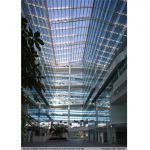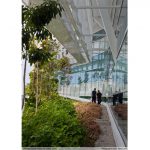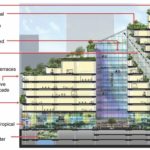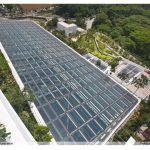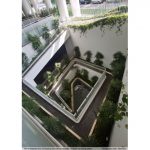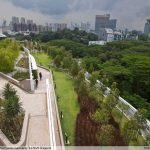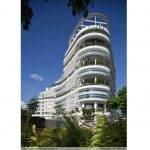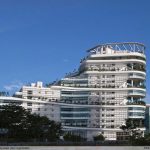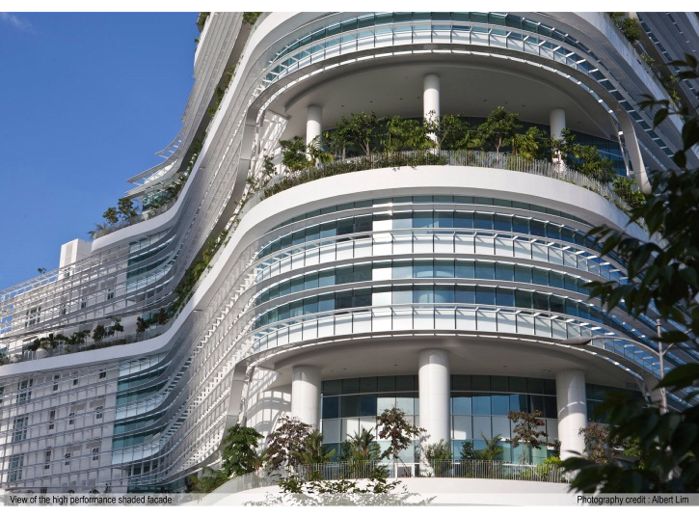
Additional Resources
The SOLARIS, Fusionopolis (Phase 2B), One North Singapore building is open to the public except for selected areas for which an appointment with the owners, the SoilBuild Group Holdings, would be required.
For more information about SOLARIS, contact T. R. Hamzah & Yeang Sdn. Bhd. at: +6 03 4257 1966 / +6 03 4257 1948; www.trhamzahyeang.com; or trhy@trhamzahyeang.com.
Case Studies
T. R. Hamzah & Yeang; CPG Consultants Pte Ltd.
Video
Watch the 2:33 video SOLARIS, Fusionopolis (Phase 2B) – Project of the Week 4/28/14 from Greenroofs.com on the greenroofsTV channel on YouTube.
News
April 25, 2014 SOLARIS at Fusionopolis (Phase 2B): From Military Base to Bioclimatic Eco-Architecture by T. R. Hamzah & Yeang Sdn. Bhd. on Greenroofs.com.
SOLARIS is a 15 story office building located in the Fusionopolis hub in central Singapore’s one-north business park, an area dedicated to research and development in technology, media, physical sciences & engineering industries. The site was originally a military base, which meant that most of the original ecological system had been destroyed. The architect’s response was to conserve what little greenery there was by building on areas which would cause the least ecological damage, helping to improve the site’s biodiversity simply through the positioning of the building.
The site of the project is part of a master plan designed by Zaha Hadid Architects in 2008. It received a Platinum Rating – BCA GreenMark 2009 from the Singapore Building Control Authority and First Prize – Skyrise Greenery Awards 2009 from the Singapore Institute of Architects & Singapore National Parks, among numerous other awards.
SOLARIS is comprised of two towers connected with a passively-ventilated central atrium. Office floors are linked by a series of sky terraces which span the atrium at upper floors. The architect designed over 8,000 square meters landscaping, a total more than the area of building. The “eco-building” replaced the original site with a ratio of 108% of landscape to site area. Through the eco-building, sustainable design features and innovative vertical green concept, SOLARIS strives to enhance the site’s existing ecosystems, rather than replace them.
Building Green Design Strategies: The building has accomplished a 36% reduction in overall energy consumption by integrating fully landscaped areas directly into the facade of the building. The green design strategies of the building areas are as follows:
Continuous Perimeter Landscape Ramp
Rainwater Harvesting/Recycling
Roof Gardens and Corner Sky Terraces
Climate Responsive Facade
Naturally Ventilated and Day Lit Grand Atrium
Pocket Park / Plaza
Solar Shaft
Extensive Sun-Shading Louvers
Eco-cell
The “green ramp” at SOLARIS is a 1.5 kilometer linear, continuous landscape ramp that was built to connect the ground level to the upper levels of the building, linking the basement Eco-cell with a cascading sequence of roof-gardens at the highest levels. The ramp has deep overhangs with large concentrations of shade plants as a comprehensive strategy for ambient cooling of the building facade. The maximum slope or gradient of the ramps is 1:20.
Ground level landscaping, linking to One-North Park across the street, allows for cross ventilation of the ground-floor plaza and provides a venue for social and interactive events. The Eco-cell is located at the building’s north-east corner to allow for vegetation, daylight and natural ventilation to extend into the car-park levels below. The lowest level of the Eco-cell contains the storage tank and pump room of the rainwater harvesting system.
The roof gardens and corner sky terraces act as a thermal buffer and creates areas for relaxation and event spaces. These extensive gardens allow building occupants to interact with nature and offer opportunities to experience the external environment and enjoy views of the treetops of the adjacent One-North Park. As it reaches each corner of the building the spiral ramp expands into generous double-volume sky terraces. The sum of its vegetated areas exceeds the footprint of the site on which the building sits. A dramatic vision of the possibilities inherent in skyrise greenery design, 95% of the project’s total landscaped area is above ground level.
Vertical Vegetation Features Overview:
Vertical landscaping acts as a thermal buffer and creates areas for relaxation and event spaces. These extensive gardens allow building occupants to interact with nature and offer opportunities to experience the external environment and enjoy views of the treetops of the adjacent One-North Park. As it reaches each corner of the building, the spiral ramp expands into generous, double-volume sky terraces. A dramatic vision of the possibilities inherent in Skyrise greenery design, 95% of the project’s total landscaped area is above ground level.
The main greenery features are:
Extensive greenery
Over 100% green replacement of original plot area. (108%)
The Green Areas, themselves, include*:
Roof Gardens: 2,987 m2
Atrium Planter Boxes: 304 m2
Green Ramp: 4,115 m2
Ground Level Landscaping: 487 m2
Green Walls: 164 m2
Total Landscaped Area: 8,363 m2
Ratio of Landscaping to GFA: 17% Green
Ratio of Landscaping to Site Area: 108% Green
Percentage of Total Landscape Area above Ground Level: 95%
* The total “Roof Size” of 84,777 sf in this profile encompasses all of the above, including the Green Walls, minus the Ground Level Landscaping figure.
The lack of deep soil meant that the plant species – including shrubs, groundcovers, palms, and trees – had to be carefully selected to ensure that their roots are able to spread horizontally, instead of digging deep downwards for stability.
To see the complete Project Teams and learn about Primary Functions and Facade Overview, Vertical Vegetation System Overview, Irrigation System, Plant Species, Maintenance Strategy, Analyses of Strengths and Limitations, plus Additional Resources including Awards, Publications, and References & Further Reading, read the April 2014 Guest Feature Article on Greenroofs.com, listed below.
 Greenroofs.comConnecting the Planet + Living Architecture
Greenroofs.comConnecting the Planet + Living Architecture
